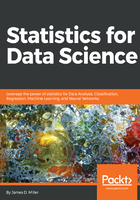
Adding to your personal toolbox
In my experience, most data developers tend to lock on to a technology or tool based upon a variety of factors (some of which we mentioned earlier in this chapter) becoming increasingly familiar with and (hopefully) more proficient with the product, tool, or technology—even the continuously released newer versions. One might suspect that (and probably would be correct) the more the developer uses the tool, the higher the skill level that he or she establishes. Data scientists, however, seem to lock onto methodologies, practices, or concepts more than the actual tools and technologies they use to implement them.
This turning of focus (from to tool to technique) changes one's mindset to the idea of thinking what tool best serves my objective rather than how this tool serves my objective.
An exciting example of a currently popular data developer or data enabling tool is MarkLogic (http://www.marklogic.com/). This is an operational and transactional enterprise NoSQL database that is designed to integrate, store, manage, and search more data than ever before. MarkLogic received the 2017 DAVIES Award for best Data Development Tools. R and Python seem to be at the top as options for the data scientists.